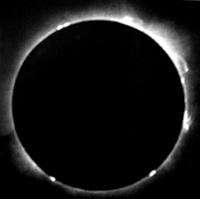| Solar eclipse of April 17, 1912 | |
|---|---|
| Type of eclipse | |
| Nature | Hybrid |
| Gamma | 0.528 |
| Magnitude | 1.0003 |
| Maximum eclipse | |
| Duration | 2 s (0 min 2 s) |
| Coordinates | 38°24′N 11°18′W / 38.4°N 11.3°W |
| Max. width of band | 1 km (0.62 mi) |
| Times (UTC) | |
| Greatest eclipse | 11:34:22 |
| References | |
| Saros | 137 (30 of 70) |
| Catalog # (SE5000) | 9308 |
A total solar eclipse occurred on April 17, 1912. It is a hybrid event, starting and ending as an annular eclipse, with only a small portion of totality. Totality was visible over the sea between Spain and France, with annularity continued northeast across Europe and Asia.
This eclipse occurred two days after the Titanic sunk in the northwestern Atlantic ocean under the darkness of new moon.[1]












